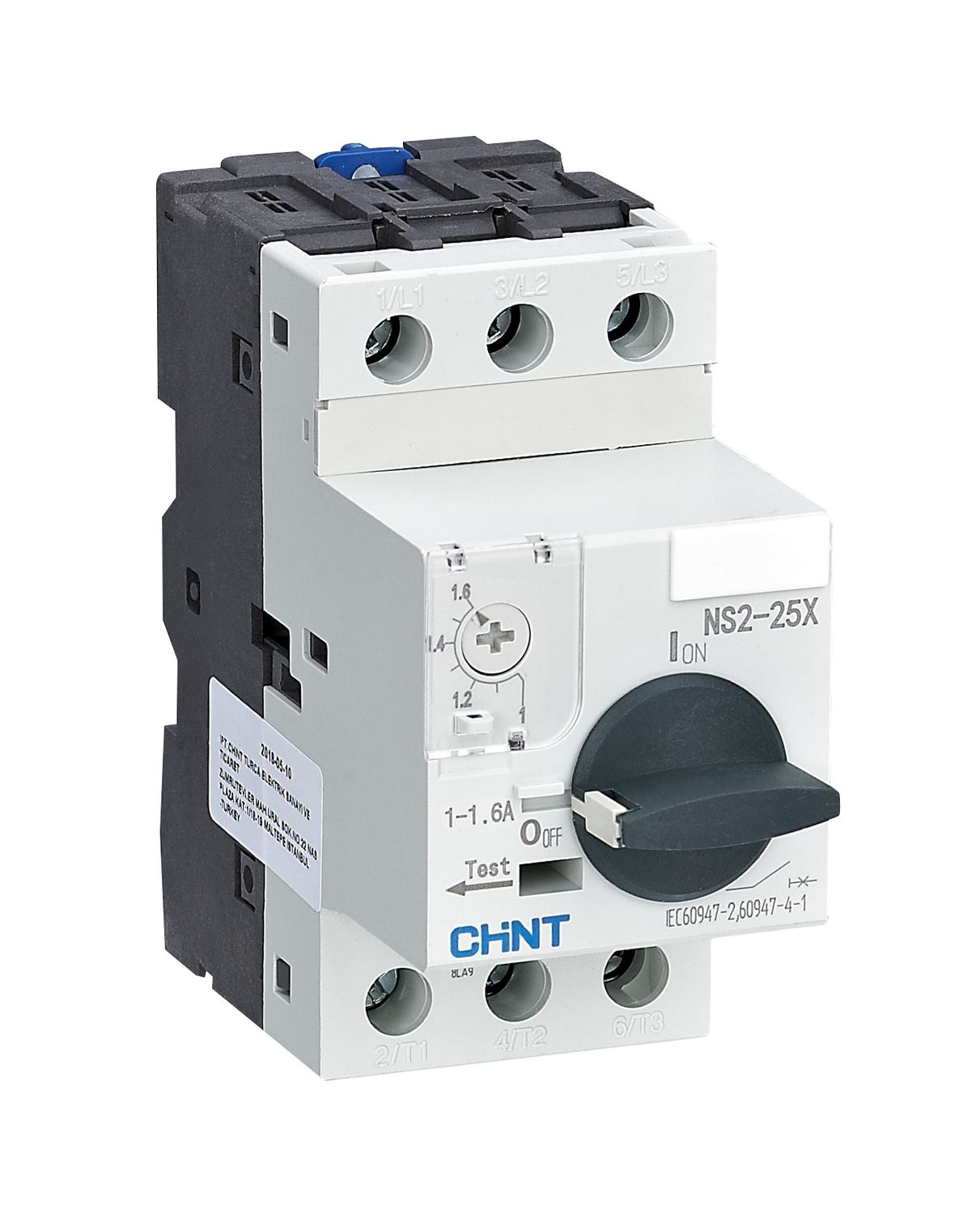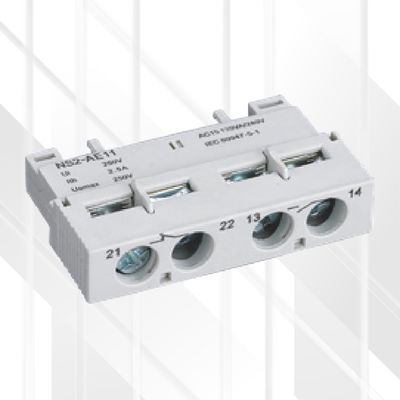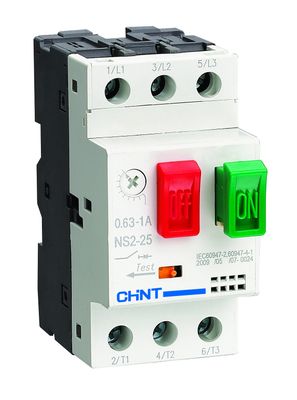CHINT NS2 Manual Motor Starter (Rotary Type)
CHINT NS2 Manual Motor Starter (Rotary Type)
- The CHINT NS2 series of rotary manual motor starters, including the NS2-25X, NS2-32X, and NS2-80 models, offers reliable manual control and comprehensive protection for 3-phase AC motors.
- Featuring a robust rotary handle for ON/OFF switching and reset, these starters are designed for infrequent starting of motors up to 690V AC.
- They provide essential protection against short circuits, thermal overloads, and phase loss, enhancing motor longevity and system reliability.
- Suitable for direct-on-line applications, they can also function as distribution line protectors or manual isolators.
- Compliant with IEC/EN 60947 standards, these starters support a wide array of accessories for extended control and signaling capabilities.
Features
-
Manual Rotary Handle Operation (ON/OFF/Reset)
-
Adjustable Thermal Overload Protection (Wide setting ranges per model)
-
Instantaneous Short-Circuit Protection
-
Phase Loss (Phase Failure) Sensitivity
-
Suitable for AC-3 Motor Duty
-
Rated Operational Voltage up to 690V AC
-
Trip Class 10/10A
-
Ambient Temperature Compensation
-
Can be used for Distribution Line Protection or as an Isolator
-
IP20 Protection (Standard Unit)
-
Compatible with a wide range of accessories (Auxiliary Contacts, Shunt/Undervoltage Releases, Enclosures)
-
Compliant with IEC/EN 60947-2 and IEC/EN 60947-4-1
-
Certifications including CE, EAC, UL (check specific model/region)
Benefits
-
Dependable Motor Safeguarding: Protects motors against damaging overloads, short circuits, and phase loss conditions, reducing maintenance costs and downtime.
-
Clear Operational Status: The rotary handle provides a distinct visual indication of the ON or OFF state.
-
Accurate Protection: Adjustable thermal settings allow precise matching to motor FLA, ensuring reliable protection without unnecessary tripping.
-
Enhanced Safety: Includes manual isolation capability. Phase failure sensitivity prevents motor operation under potentially damaging conditions.
-
Versatile Functionality: Suitable for motor control, distribution circuit protection, and use as a main or local disconnect switch.
-
System Integration: Accessory options allow for remote status indication, control interlocking, and remote/automated tripping.
-
Standard Compliance: Meets international safety and performance requirements for industrial equipment.
Technical Specifications
General Environmental & Operational Parameters:
-
Ambient Temperature: -5°C to +40°C (Average over 24h ≤ +35°C)
-
Relative Humidity: ≤ 50% at +40°C; up to 90% at +20°C
-
Altitude: ≤ 2000m (derating may be required above 2000m)
-
Pollution Degree: 3
-
Installation Category: III
-
Rated Frequency: 50/60 Hz
-
Rated Insulation Voltage (Ui): 690V
-
Rated Impulse Withstand Voltage (Uimp): 8kV
-
Duty: Continuous / Long Term / Eight-hour day
-
Enclosure Protection: IP20 (Unit)
-
Max Operation Frequency: ≤ 30 times/hour (NS2-25X/32X), ≤ 25 times/hour (NS2-80)
-
Standards: IEC/EN 60947-2, IEC/EN 60947-4-1
Model-Specific Details:
| Model | Setting Current Range (A) | Motor Rating AC3 (400V) |
|---|---|---|
| NS2-25X | 0.4-0.63 | 0.18kW |
| NS2-25X | 0.63-1 | 0.25kW |
| NS2-25X | 1-1.6 | 0.37 / 0.55kW |
| NS2-25X | 1.6-2.5 | 0.75kW |
| NS2-25X | 2.5-4 | 1.1 / 1.5kW |
| NS2-25X | 4-6.3 | 2.2kW |
| NS2-25X | 6-10 | 4kW |
| NS2-25X | 9-14 | 5.5kW |
| NS2-25X | 13-18 | 7.5kW |
| NS2-25X | 17-23 | 11kW |
| NS2-25X | 20-25 | 11kW |
| NS2-32X | 24-32 | 15kW |
| NS2-80 | 30-40 | 18.5kW |
| NS2-80 | 48-65 | 30kW |
| NS2-80 | 63-80 | 37kW |
Compatible Accessories:
-
For NS2-25X / NS2-32X:
-
Undervoltage Release: NS2-UV110, NS2-UV220, NS2-UV380
-
Shunt Release: NS2-SH110, NS2-SH220, NS2-SH380
-
Auxiliary Contact (Front): NS2-AE20 (2NO), NS2-AE11 (1NO+1NC)
-
Auxiliary Contact (Side): NS2-AU20 (2NO), NS2-AU11 (1NO+1NC)
-
Fault Signal Contact: NS2-FA0110, NS2-FA0101, NS2-FA1010, NS2-FA1001
-
Waterproof Enclosure: WPB-1 (IP55)
-
-
For NS2-80:
-
Undervoltage Release: NS2-UV110, NS2-UV220, NS2-UV380
-
Shunt Release: NS2-SH110, NS2-SH220, NS2-SH380
-
Auxiliary Contact (Front): NS2-AE20 (2NO), NS2-AE11 (1NO+1NC)
-
Auxiliary Contact (Side, Specific): NS2-AU20(NS2-80) (2NO), NS2-AU11(NS2-80) (1NO+1NC)
-
Conversion Connector (for NC8-65 Contactor): CC-3(NS2)
-
Wiring & Terminals:
-
Conductor Cross-Sectional Area:
-
NS2-25X/32X: 1 - 6 mm² (Refer to Table 7 in manual for specific current ranges)
-
NS2-80: 4 - 25 mm² (Refer to Table 7 in manual for specific current ranges)
-
-
Strip Length: 10 mm (NS2-25X/32X), 10 mm (NS2-80)
-
Max Conductors per Terminal: 2 (NS2-25X/32X), 1 (NS2-80)
-
Terminal Screw Size: M4 (NS2-25X/32X), M8 (NS2-80)
-
Tightening Torque: 1.7 N.m (NS2-25X/32X), 6 N.m (NS2-80)
Find The Accessories:
Ideal Use
-
Direct-on-line (DOL) starting and protection of 3-phase asynchronous motors where rotary handle operation is preferred.
-
Machine tools, pumps, fans, conveyors, and other industrial machinery.
-
Agricultural equipment.
-
Building services (HVAC).
-
Protection and isolation of distribution circuits.
Tips
-
Installation: Only qualified technicians should install or maintain these starters. Always disconnect power before working. Install in environments free from excessive moisture, dust, flammable gases, vibration, or shock. Ensure vertical mounting (max 5° inclination).
-
Wiring: Use appropriate wire gauges based on current ratings (see manual tables). Ensure correct wire stripping length (10mm) and tighten terminals to specified torque (1.7 Nm or 6 Nm) for reliable connections.
-
Setting Overload: Adjust the thermal overload dial to match the motor's nameplate Full Load Amperes (FLA). For intermediate values, slightly turn the cam proportionally. Test operation after setting.
-
Backup Protection: If the installation's potential short-circuit current exceeds the starter's Icu rating, use correctly rated backup fuses (aM or gG/gL) or a circuit breaker as specified in the manual's coordination tables (e.g., Table 8).
-
Maintenance: Regularly clean dust from the starter. Perform functional tests and check terminal tightness periodically (e.g., semi-annually).
-
Handling: Avoid impacts or improper handling (like using cranes) that could affect the starter's performance or protection characteristics.
-
Troubleshooting: Refer to the user manual's troubleshooting section (Table 9) for guidance on issues like premature tripping or failure to operate. Check settings, connections, ambient conditions, and motor load.




